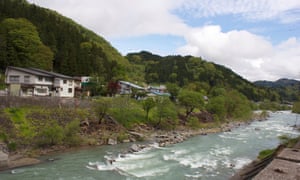Keito Kobayashi has swapped his usual work clothes for the uniform of his second job as a volunteer firefighter. He is, the caption in the calendar says, only doing what comes naturally – keeping his family and his village safe. Seigo Fujiwara’s picture shows him staring into the middle distance, his head swathed in a traditional . The 29-year-old surveyor is looking for a woman with a “beautiful smile” with whom he can travel the world.
They and 10 other men from Otari are the faces of Japan’s ticking demographic time bomb. They hope their calendar poses will generate interest from potential love matches and help end their search for love and companionship.
Finding a partner in Otari, a village in Nagano prefecture in Japan’s northern Alps known for its dramatic scenery and some of the best skiing in the country, is proving a thankless task for Kobayashi and his friends.
Its population is about a third of what it was in the 1950s; in the past decade, the number of residents has fallen from 3,734 to 2,795, including fewer than 180 children of primary and middle school age.

According to the National Institute of Population and Social Security Research, its population will fall to just over 900 by 2060 if current demographic trends persist. As of last March, just 275 men and 218 women in their 20s and 30s lived in Otari.
Young women are more likely to leave in search of jobs, and perhaps a partner, while the men are expected to stay and inherit family farms and businesses, leaving them with little prospect of marrying and having children.
Otari’s predicament is repeated in many places across the country. According to one study, 869 municipalities – almost half the national total – are at risk of disappearing due to the low birth rate. In a report titled Local Extinctions, the Japan policy council said those towns and villages would cease to function if the number of women in the 20-39 age group falls by more than half by 2040.
‘Money well spent’
Yuki Nozaki Quilkey, a former foreign ministry official who advises Otari’s mayor, came up with the idea after seeing the success of the New York fire department’s Calendar of Heroes.
She is convinced that Otari’s best hope of long-term survival is attracting a small number of young professionals who are sick of city life but do not have any connection to the countryside.
She is behind a programme to disassemble some of the village’s grand, but abandoned, farmhouses and move them to more convenient locations in the hope of attracting start-ups. Two tech companies are due to start sharing a renovated 250-year-old house in the village next year.

“The time came to dispense with the laissez-faire attitude and actually do something to rejuvenate the village by incorporating its assets into a proper business model,” she says. “The calendar was the first step in changing that mindset. It was money well spent.”
Kobayashi, who works in the village office, was instrumental in rounding up the 11 models and says he encountered surprisingly little resistance. “There are very few opportunities to meet young women here – and I speak from experience,” he says.
Kobayashi and the other calendar models are reluctant, though, to go through the upheaval required to take their search farther afield. He partly attributes that to a “village mentality”, but says there are clear advantages to life in this unspoiled corner of northwest Nagano prefecture.
“I went to university in Tokyo and I would get stressed out just taking the subway in the morning,” he says. “Here it’s a totally stress-free existence.”
The calendar lists the models’ professions and hobbies, and a few words about their goals in life and their ideal partner. To date, the village office has received enquiries from eight women, four of whom have followed up by sending in their photographs and profiles.
‘I don’t want to stay single’
While Japan has seen a slight rise in the fertility rate in recent years, government incentives such as one-time cash payouts have had limited impact. In Otari, parents with bigger families receive one-off payments that rise with each child, as well as discounts on education fees. But the return has been minimal.
“We don’t have a silver bullet for depopulation,” the mayor, Hisashi Matsumoto, conceded. “The population will probably continue to fall, but if we can persuade more families to have, say, three children, then we can at least slow down the rate of decline.
“At the very least I want the people who already live here to lead as happy and healthy lives as possible. The same goes for anyone who decides to move here.”
Daniel Hunter, a 21-year-old Australian who is in the middle of a plastering and tiling apprenticeship, has fallen for Otari since his first visit to the area a few years ago. He is single and wouldn’t mind having a girlfriend, but sees the calendar as more of a PR opportunity for the village than a personal plea for companionship.
“I thought it was a cool opportunity to show people that there are foreigners living happily here,” says Hunter, whose parents spend every winter running a ski lodge nearby. “I can see myself sticking around for a while, although there are times when I wish it was a bit livelier.”

No one in Otari expects the calendar to spark an influx of young women and a localised baby boom. But Fujiwara, who doubles as Mr May, hopes it will get people talking about the village.
“I’m part of a family business so I will be here for the foreseeable future,” he says. . “In any case, moving to a place where there are more women would mean there are also more men, who would be my rivals.”
At 26, Kobayashi is not fretting about marriage just yet. But he is typical of many Otari men who must reconcile their determination to stay put with a desire to find a life partner. “The thought of leaving the village has never crossed my mind,” he says. “But I don’t want to stay single either.”